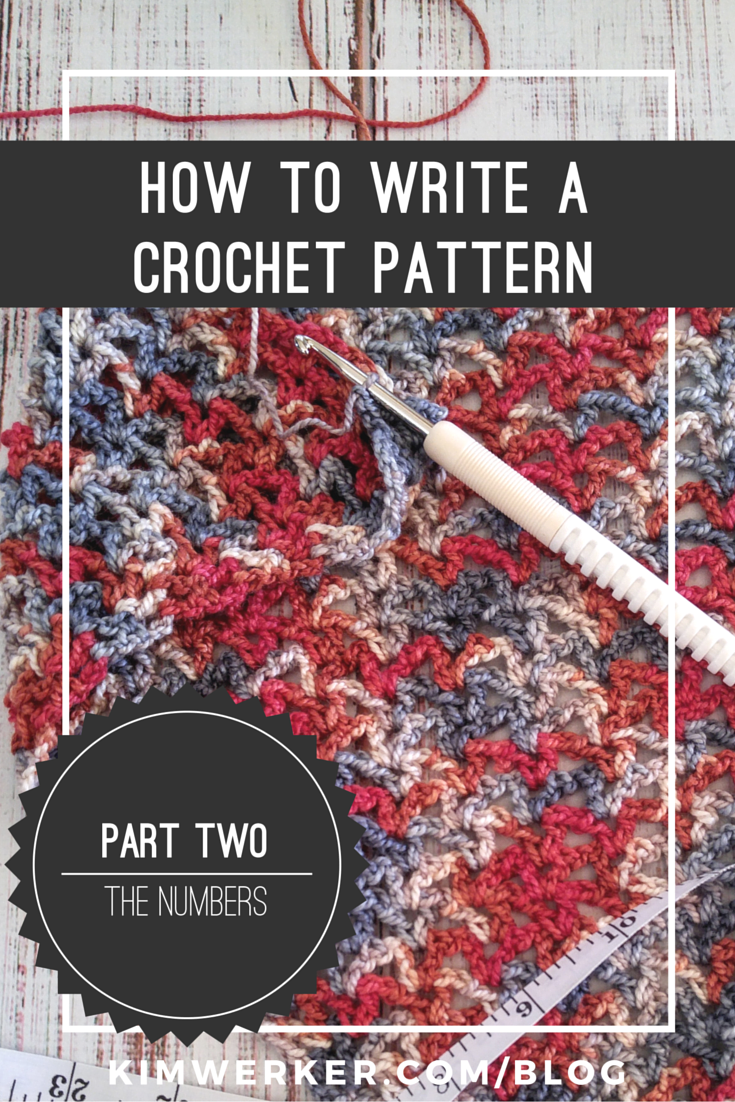This is the 2nd post in a 7 part series on how to write an outstanding crochet pattern. The rest of the series can be found here: part 1, part 2, part 3, part 4, part 5, part 6, part 7. There are five posts from me, and two fabulous guest posts from Kate Atherly.Â

There’s as much math as art involved in creating something awesome out of yarn. The key thing to keep in mind when you write up the pattern for your creation is that the follower of that pattern does not know what you know. Take no assumption for granted beyond the crocheter’s knowledge of how to make individual stitches. Your job is tell them what stitches to make, in whatever order and combination produces your design. And you need to give them exact, precise information that will enable them to know they’ve got it right, or to diagnose where they’ve gone wrong.
Pattern Numbers Dos and Don’ts
Here are some dos and don’ts about treating numbers – and everything to do with them, including but not limited to measurements, stitch counts, gauge and sizing – in your pattern:
- Do provide the finished dimensions of the project, including measurements for all critical parts of the design.
- Do provide gauge information. Do not skip this under any circumstances, even if you think the exact dimensions of the finished project aren’t important. You must give your crocheters the information they need to make the best possible project. Always, always list the gauge.
- You must be specific when telling the crocheter how you’ve determined the gauge required to replicate your design. Unless the entire design is created using one kind of stitch exclusively, you must specify exactly which stitch you used to determine gauge, or which stitch pattern. If you don’t provide this specific information, your crocheter won’t know how to match your gauge, and they’ll give up in frustration, or they’ll forge ahead without knowing if they’ll be successful with their project, or they’ll (rightfully) inundate you with emails asking for clarification. Here are a few examples of properly listed gauge information:
12 sc and 12 rows = 4″ (10 cm).
12 sts and 12 rows = 4″ (10 cm) in sc.
9 sts and 7 rows = 4″ (10 cm) in stitch pattern (see Special Stitches).
- Don’t be lazy about sizing. If your pattern is for a garment, do not offer it in only one size and tell crocheters that they need to do the work to resize it. Obviously, you don’t need to include every imaginable size, but don’t be lazy about sizing. It’s totally fine to provide a range of sizes and then expect individual crocheters to adjust particulars on their own. It’s not okay to be lazy. Don’t be lazy.
- Do provide the total stitch count at the end of every row or round that involves a change in that total. If you call for increasing or decreasing, or if you change up the stitch pattern, list the total number of stitches (or some other designation like the total number of shells, pattern repeats, whatever is most straightforward to count) at the end of that instruction. If your pattern calls for a repeat of increase or decrease rows, instead of a total stitch count, indicate the number of stitches added or removed from the total. For example:
Row 5: Ch 3, [(v-st, ch 1) in each ch-1 space of inc-w] 2 times, dc in top of tch, turn – 4 v-sts.
Row 12: Ch 3, inc-w in first v-st, ch 1, (v-st, ch 1) in each v-st to last v-st, inc-w in last v-st, dc in top of tch, turn – 2 sps increased.
- If you have a repeated set of increases or decreases, list the total number of stitches the crocheter should have when all repeats are completed. Like:
Rep Rows 5 and 6 three times – 10 v-sts total.
or
Rep Rows 5 and 6 three times – 9 sts remain.
- Note that in the example above, I followed a numeric digit with a number written out as a word. See the difference:
Rep Rows 5 and 6 3 times.
vs.
Rep Rows 5 and 6 three times.
- If your design involves a stitch pattern, be sure to include – in the Special Stitches section, the Notes section, or when you introduce the stitch pattern within the instructions – the general multiple of stitches the pattern requires. This enables crocheters to easily create a gauge swatch in pattern, if needed, and also to resize the overall pattern as desired while maintaining the stitch pattern.
- Imperial and metric. The vast majority of people in the English-speaking world, and most of the non-English-speaking world, use the metric system for all measurements. Most print publications based in the U.S. include both Imperial (inches and yards) and metric (millimetres, centimetres and metres) measurements in their patterns. Self-publishers should do the same, even if you’re not U.S. based, so you can meet the needs of as many crocheters as possible. You can use Google’s search bar to convert units if you don’t already have a preferred tool for doing so, just enter something like “12 inches in centimetres†and it will return the metric equivalent; the same goes for converting metric into Imperial units.
- List measurement equivalents like:
Finished length = 4″ (10 cm).
Enroll in Next Steps in Crochet!
Not writing your own patterns but ready to up your crochet game? To celebrate this long-in-the-making blog series, here’s Next Steps in Crochet! See you there!
